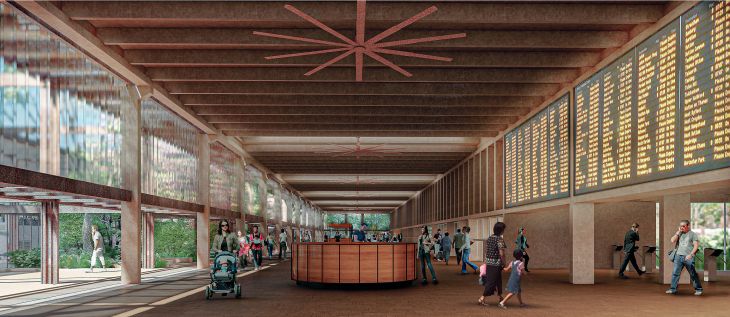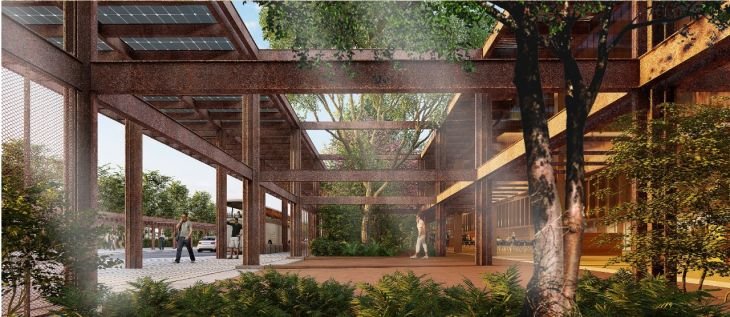It will be sustainable, friendly to the environment and linked to the communities, say designers
Valladolid, Yucatan, (December 15, 2021).- If the Mayan Train station in Valladolid could be described in a few words, it would be: an access door, a farewell door, portals and gardens; a place of escape where people can enter or wait comfortably, quietly, at a regulated temperature, surrounded by a beautiful wooded landscape and full of portals, this is how those responsible for creating the design of this station summarized the project.
In an interview, the architects Izbeth Mendoza Fragoso, Román Cordero Tovar, and David Sosa Solís, members of the local studio Plug Architecture, responsible for designing this work, talk about the challenges that this work represented; which, in addition to containing a sustainable approach, being friendly to the environment, flora and fauna and the use of clean energy, highlights the link with the surrounding communities for its design.
.JPG)
Cordero Tovar highlighted that all his works contain an urban, architectural, and landscape component, this project represents the access door coming from Quintana Roo and leaving for Yucatan, therefore, they focused on the strength of an access or exit door, he counted.
“We liked the word portal, which encompasses the broadest sense of the door of access, entry, and farewell,” he said.
We believe, he added, that within the local tropical architecture, the concept of portals is something very common, this idea of transition from an exterior to an interior place.
The specialist explained that the premise on which the project is based is “a very long bay, a landscaped portal”, and is also consistent with the use of the territory.
“Accompanied by a parallel garden that can serve as a standard of what for us is a vernacular architecture, the sum of a modulated issue accompanied by the landscape.”

They estimate that there would be at least 70 percent of green areas allocated to the entire four-hectare plot that would cover the entire season.
Izbeth Mendoza specified that they did not look for a particular style, because the interest behind everything they do is to be able to understand the site well, what would be there and the landscape part they not only see as something aesthetic, “that it looks good”, but as “that place of escape in which if I am with my children and we are waiting, it becomes that portal to slow you down a little the speed at which you come, and that reassures.”
For this reason, she added, it is important to work with native vegetation, which in addition to providing comfort and tranquility, regulates the temperature; and other benefits such as care, protection of birds, fauna.
.JPG)
“This is not only a station for people, but for flora and fauna and local communities,” said Román Cordero. Today architecture necessarily has to have a biocultural focus, he added.
Sustainable approach
According to the architect, the design is based on a sustainability approach that meets several aspects, which has to do with vegetation and economics, that is, it is a structure that rescues rails to make pergolas, sleepers to make squares, he added Lamb Tovar.
“It works with that cultural memory and the people, it is a station that allows the marketing of handicrafts, community work,” he said.
Also, in the upper part of the portals, it has a solar cover that captures the sun’s energy, which represents that around 50 percent of the station will be clean. “It is a crystal that has a photovoltaic plate immersed,” he said.
David Sosa specified that this covering of these crystals reduces the amount of radiation that passes to the user, captures it, and develops it into energy so that the temperature of the place would be regulated and there will be no heat impacts, as in other works that are “Concrete stains” or “heat islands”.
There will be no air conditioning systems, he added, also the orientation and placement of separate tiles in sections allow air circulation, generating natural ventilation; attached to the gardens. “In addition to reducing the sunlight that goes over the building, it generates shade, lowers the temperature, refreshes the environment,” stressed the urban planner.
.JPG)
At the same time, the architects highlighted that with their design they want the station to be a meeting center, of services for the local population, where they can go to do their daily activities, which goes with the vision of the Maya Train.
The infrastructure includes an artisan market area so that the communities have a space where they can offer their products, crafts, and other creations for travelers and people who come to the property.
Accessible architecture
Another important component of the station is that it has a universally accessible architecture, that is why all the money is one level, in addition, it takes into account the needs of people with a disability.
The project is also contemplated so that it “ages with dignity”, that is to say, that not much work is done to give it maintenance every certain time; Contains materials that do not require frequent cleaning.
“Maintenance is something that for us in a public building, we have to take great care of, the less cleaning is required, the more successful it can be,” said Izbeth Mendoza.
Link with communities
The residents of the nearby communities, such as Chanyokdzonot, were of vital importance for the design of the station, they took it into account for the decisions, they said.
One of the main demands was to have a direct point of contact where they can sell their crafts and products with all the people who will move through the station and the train, they added.
For Román Cordero this work has represented a challenge: it is a very ambitious project and someone from a local studio is building a Maya Train station, “we are very lucky, it is still a challenge, this will not stop until it is finished”.
Source: La Jornada Maya
TYT Newsroom



